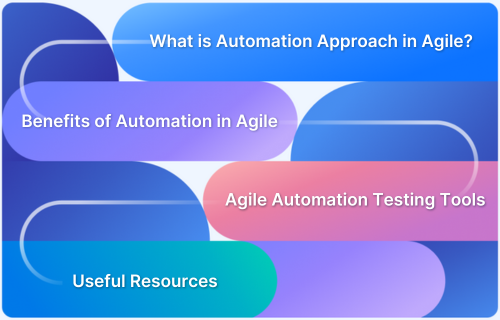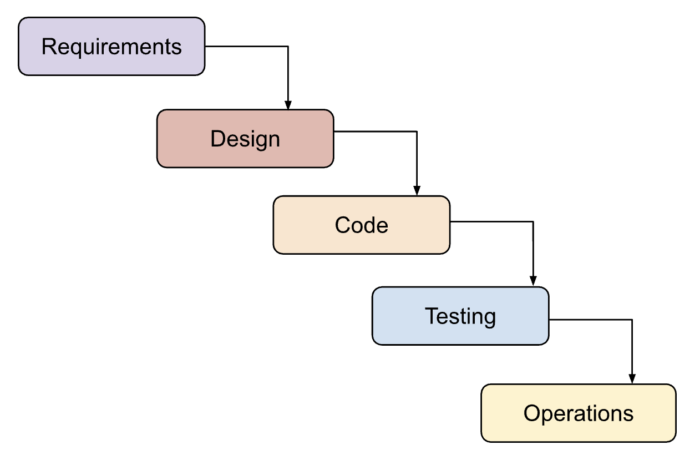Delivering high-quality software within tight deadlines is essential in agile development. With frequent updates and rapid release cycles, manual testing becomes impractical.
Automation testing ensures faster feedback, comprehensive test coverage, and efficient defect detection, enabling teams to validate new features while maintaining existing functionality seamlessly.
This article explores why automation testing is central to agile development and how it enhances efficiency, reliability, and product quality.
Software Development before Agile
Before the emergence of Agile development principles, software development often followed the Waterfall Model. In fact, Waterfall was the first model commonly used for software development.
As the name suggests, this model treated development in a linear fashion, like the flow of a waterfall. Developers work on phases, and each step must be completed before another begins.
As the image displays, testing in the waterfall model comes at the end of all development. That means, to use the example in the intro, Bob will have to finish the development of a new feature (let’s say a whole new quest) before he can test it. If bugs show up, Bob will have to return to his code, comb through every line, and try to find the error(s).
Additionally, even the slightest change in requirements (say, a change has to be made due to some users’ feedback that has come in a day ago) requires the whole process to be repeated. More coding, more testing. Needless to say, this process is not remotely time-efficient.
How Agile Transformed Software Development
As the image shows, Agile development changes the games by making it more flexible. While using Agile principles, Bob would develop, test, and release a basic but fully functional version of the quest to meet the users’ demand. Then he would go back and keep refining the quest, adding new design, gameplay elements, weapons, character styles so that the users stay interested and delighted.
Agile focuses on releasing working software. To do so, developers and testers work in teams to complete and release functioning applications. The database, business logic, and user interface of a part of the software is developed and pushed to production at one go, instead of the whole application.
To do this at high speed (usually within a couple of weeks), collaboration is indispensable. Teams have to interact frequently so that everyone is on the same page about what is being built, every member’s responsibility, and the overall team alignment.
What is Automation Approach in Agile?
Agile test automation refers to the use of automated testing tools and frameworks to support the testing efforts in an Agile software development process. Agile test automation is used to automate the testing of software features, which helps to improve the speed, accuracy, and efficiency of the testing process.
In an Agile development process, software is developed in short iterations, with new features being added and tested in each iteration. Agile test automation enables the testing team to keep up with the rapid pace of development by automating the testing of repetitive and time-consuming tasks, such as regression testing.
How does Automation Testing Fit into Agile?
Accelerated product release requires accelerated coding, which needs accelerated testing. Every time an application (or updates to the application) hits the market, it needs to be perfectly functional for each user. Otherwise, users will simply switch to a competitor and also post a slew of negative reviews that will lead to a loss of credibility for the application.
The only way to ensure flawless functioning is to test each feature and update comprehensively. To do so manually in restricted timelines for complex, feature-rich software is impossible. Automation is the only recourse.
Automation testing in Agile allows for QAs to create test cases that will run automatically every time new code is pushed to the code repository for a specific application. This practice is called Continuous Testing in DevOps and ensures that new code is bug-free before it hits the production environment.
Continuous Testing in Agile is a stage in a development system named CI/CD, AKA Continuous Integration/Continuous Deployment. CI/CD automates the process of code moving through the stages of Development -> Testing -> Deployment.
Automation testing in Agile is implemented via several tools and frameworks such as Selenium and Cypress. Implementation of CI/CD also requires a specific set of tools, namely Jenkins, Travis CI, TeamCity, Bamboo, CircleCI, Azure Pipelines, etc.
Using these tools, QAs can develop test cases in alignment with the nature and need of the application at hand. Once crafted, these test cases are run automatically on each piece of code added to the existing application. The tests verify that each line of code is bug-free and that newly created code does not damage or interfere with the existing features (via regression testing).
Read More: Agile vs DevOps: What’s the Difference?
Benefits of using Automation in Agile
Automation plays a vital role in Agile development by streamlining processes, reducing manual effort, and ensuring faster, high-quality software releases. Here are the key benefits:
- Enhanced Efficiency: Automating repetitive tasks like testing and deployment minimizes manual effort, streamlining workflows and boosting overall efficiency.
- Higher Productivity: By reducing time spent on routine processes, teams can focus on critical tasks, leading to faster software delivery and improved productivity.
- Superior Quality Assurance: Automation reduces human errors, ensures consistency, and enhances software quality through systematic testing and deployment.
- Accelerated Time-to-Market: Automated testing and deployment processes speed up development cycles, enabling quicker software releases.
- Greater Flexibility: Automation allows teams to adapt swiftly to evolving requirements and market demands, fostering agility in development.
- Cost Efficiency: Reducing manual intervention and errors leads to significant cost savings in the software development lifecycle.
- Stronger Collaboration: Automated tools provide a unified platform for communication and coordination, improving teamwork among Agile teams.
- Improved Customer Satisfaction: Faster delivery of high-quality software enhances user experience and increases customer retention.
Also Read: 15 Techniques to Improve Software Quality
What is automated functional testing in Agile?
Automated functional testing in Agile refers to the use of automated testing tools and frameworks to test the functionality of software features in an Agile software development process. In an Agile development process, software is developed in short iterations, with new features being added and tested in each iteration. Automated functional testing enables the testing team to keep up with the rapid pace of development by automating the testing of repetitive and time-consuming functional tests, such as regression testing.
Automated functional tests are designed to test individual features or functionalities of the software, such as input validation, data processing, and output verification. The tests are typically created using a scripting language, and can be executed quickly and efficiently. Automated functional tests can be run repeatedly to ensure that new changes to the software have not introduced any issues or bugs, and can be integrated into the continuous integration/continuous delivery (CI/CD) pipeline to automate the testing process.
The use of automated functional testing in Agile can help to improve the speed, accuracy, and efficiency of the testing process, allowing the development team to identify and address issues more quickly, and ultimately deliver higher quality software to the end user.
Read More: Automation Best Practices to Follow
Agile Automation Testing Tools
Agile teams rely on various automation testing tools to ensure rapid and efficient software delivery. Here are some widely used tools:
- Selenium: A popular open-source framework for automating web applications across different browsers and platforms.
- Cypress: A fast, developer-friendly testing tool designed for modern web applications with real-time reloading and debugging features.
- Playwright: A powerful automation framework that supports cross-browser testing, offering reliable end-to-end testing for web applications.
- Puppeteer: A Node.js library that provides browser automation capabilities, primarily used for testing and web scraping in headless Chrome.
- Cucumber: A behavior-driven development (BDD) tool that enables collaboration between developers, testers, and business stakeholders.
- Appium: An open-source automation tool for testing mobile applications on Android and iOS devices, supporting both native and hybrid apps.
- Espresso: A testing framework for Android applications, designed to provide fast and reliable UI testing with simple and flexible APIs.
Also Read: Top 20 UI Automation Testing Tools
How to Choose the Right Agile Automation Testing Tool
Choosing the right test automation tool for an agile project requires a structured approach to ensure compatibility with project needs and team expertise. Follow these key steps:
- Define Project Requirements: Identify the type of application (web, mobile, or desktop), programming languages, frameworks, and CI/CD integrations needed.
- Research and Shortlist Tools: Compare open-source and commercial tools based on features, scalability, and compatibility with your project stack.
- Trial and Evaluate: Use free trials or demo versions to test how well the tool integrates with your workflow and meets automation goals.
- Gather Team Feedback: Involve developers and testers in the decision-making process to assess usability, efficiency, and adoption feasibility.
- Analyze Total Cost of Ownership: Consider expenses beyond licensing, including training, setup, maintenance, and infrastructure upgrades, to ensure long-term viability.
Why Choose BrowserStack Automate
QA teams need access to real devices, browsers, and OS combinations to ensure seamless software performance in real user conditions. Manual testing isn’t practical, making automation essential.
BrowserStack’s real device cloud offers a Selenium grid with 3500+ real browsers and devices, enabling agile test automation. It integrates with leading CI/CD tools and supports Cypress testing with effortless parallelization.
With real-world testing features like geolocation, network simulation, and low battery scenarios, BrowserStack ensures accurate, reliable results for cross-browser and cross-platform compatibility.
Useful Resources for Agile Methodologies
- Agile Development Methodologies: An Essential Guide
- All about Agile SDLC (Software Development Life Cycle)
- What is Agile Testing Know About Its Life Cycle, Types, and Metrics
- What is Agile Testing Quadrants: Why & How to Use It
- What is a Test Plan in Agile?
- How to Write Software Requirement Specifications in Agile
- Agile Testing Metrics that Every Tester Must Know
- 11 Agile Testing Challenges and its Solutions
- Debunking Myths about Agile Testing
- How BDD and Agile Together Make Testing Efficient
- Continuous Integration in Agile
- What does continuous delivery mean in agile?
- Risk Based Testing Approach for Agile Teams
- How to run Regression Testing in Agile Teams
- Role and Responsibilities of QA managers in Agile organizations
- Agile vs DevOps: What’s the Difference?
- Difference between CI and CD, Agile and DevOps
- Why Automation Testing is at the Centre of Agile Development
Conclusion
Automation testing is essential for Agile development, enabling faster releases, improved test coverage, and higher software quality. It ensures that teams can continuously test and validate new features without slowing down development cycles.
By integrating automation into Agile workflows, organizations can enhance efficiency, minimize errors, and deliver flawless user experiences.






